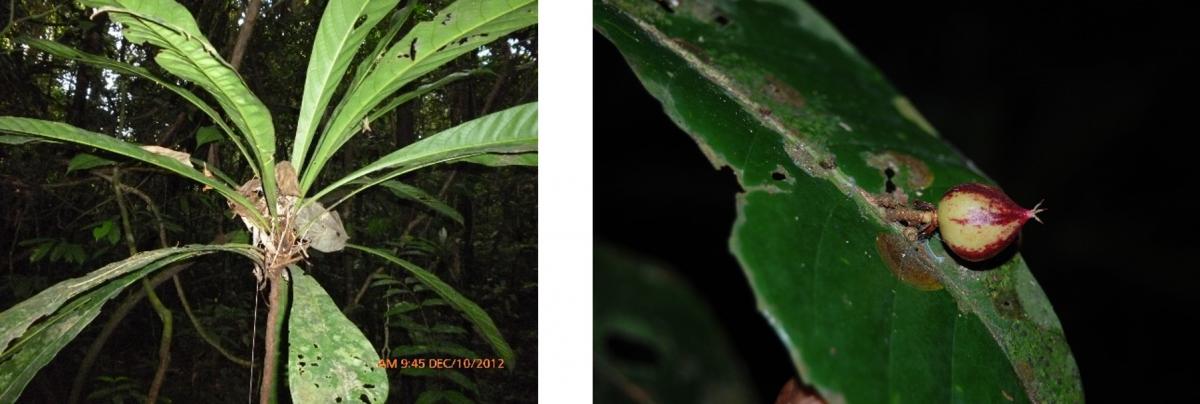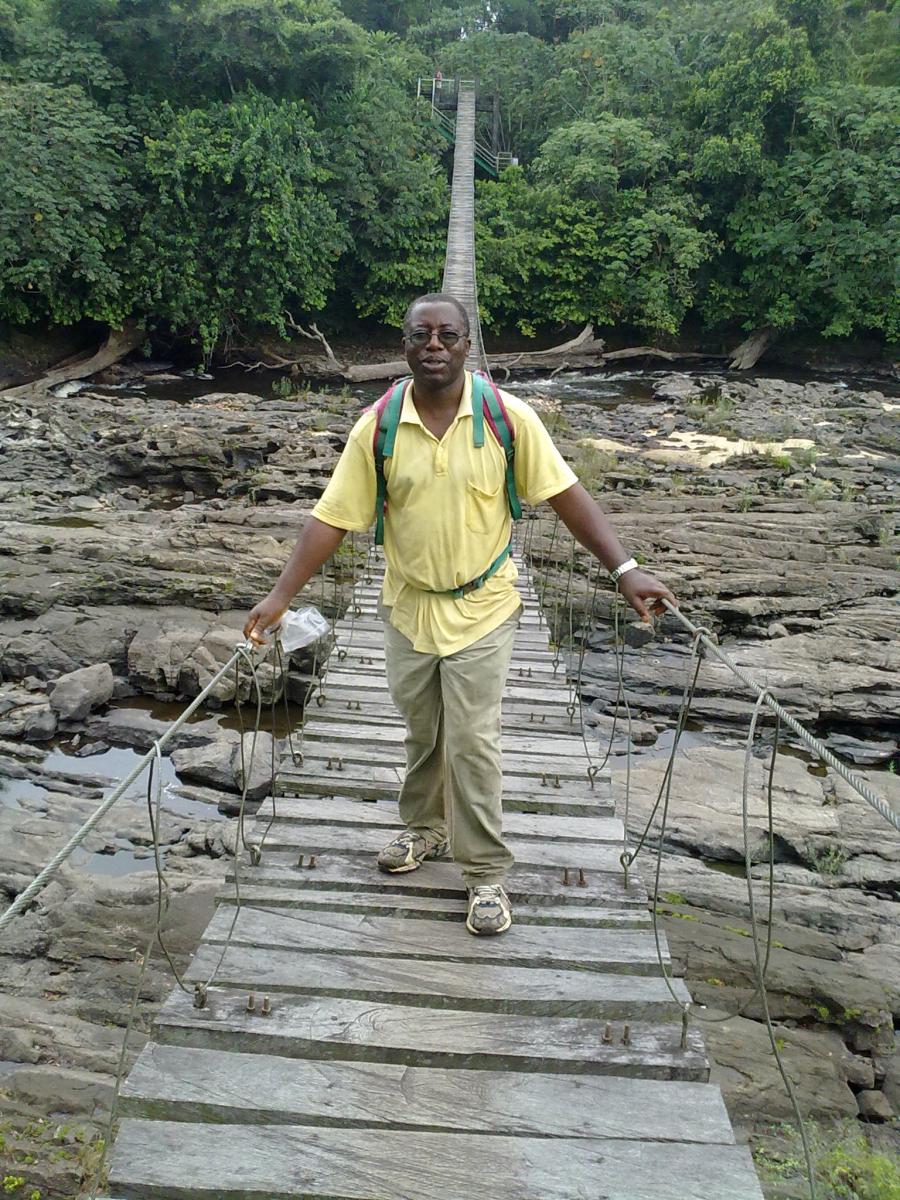Spotlight Series: George Chuyong and the Pleistocene Refugium of Korup, Cameroon
George Bindeh Chuyong is a professor in the Department of Plant Science at the University of Buea. He has been part of the ForestGEO network since 1997 when he traveled to the Ituri plot in the Democratic Republic of Congo to learn census protocols that he would apply as a PI in Korup, Cameroon. This year he is on sabbatical from University of Buea and is spending some of his time with ForestGEO. During this time he is analyzing data and finalizing manuscripts from both Korup's censuses and complimentary research projects. He has a love of ecological instrumentation and notes that Korup is one the wettest sites in all of the ForestGEO network.
What led you down the path to your current job? What has been your biggest challenge in getting to this point in your career?
Upon completion of my MSc degree in forestry at University of Ibadan, I was recruited as a research officer and later as post-doctoral assistant for a Commission of European Communities-funded research project on the ecology of ectomycorrhizal legumes in Korup National Park. The project was based at Forestry Research Station Kumba, and the Principal Investigators were Prof. David Newbery of IPS University of Bern, Switzerland and Dr Nicholas Songwe (of blessed memory), the Chief of Station. Both of them were involved in teaching and research, and during our discussions I was inspired to also impart knowledge through teaching at the tertiary level. That was how I secured a teaching position at the University of Buea in 2001.
My biggest challenge has been getting research funding as grants have become very competitive requiring teaming at all levels and forming multi-disciplinary research groups/collaborations. Communicating our findings to policy-makers has been equally challenging. The other challenge is resumption of field activities at KFDP which are temporally suspended due the insecurity currently reigning in the region.

When did you first get involved in the ForestGEO network?
I got involved in ForestGEO network in 1997 when negotiations were being finalized between BioResources Development and Conservation Program-Cameroon, the Center for Tropical Forest Science (now ForestGEO), and the Forestry Research Station Kumba to establish the 50-ha plot in Korup National Park, an area I was already so familiar with due to my postdoctoral work. My first engagement with the ForestGEO network was a visit to the Ituri plots with Dr. David Kenfack (Co-PI of Korup). Our goal was to familiarize ourselves with the CTFS protocols and logistics before we applied them as PIs in Korup. During those early stages of plot work, we attended the CTFS network meeting at the Smithsonian Tropical Research Institute in Panama and had the privilege to visit Barro Colorado Island and the premier 50-ha plot.
What is the most interesting or unique aspect of your site?
The Korup Forest Dynamics Plot is located in the heart of the tropical forest in the southern part of Korup National Park in Cameroon. Accessing the plot requires a 10km hike to Chimpanzee base camp from the Mana footbridge – the entry point to the park. This park is noted as being a pristine tropical forest and part of the Guinea-Congolian Pleistocene refugium with rare and narrow endemic tree species, categorizing it as a center of diversity with a high species endemism. The site has distinct seasons – a short and intense dry season and long wet season with mean annual total rainfall of approx. 5700mm (one of, if not the wettest site in the ForestGEO network).

plants in the plot as the flowers and fruits are borne on the midrib of the leaf.

What questions are you currently addressing in your research/site?
The main aim of KFDP has been to document, monitor, and study biodiversity in our tropical rain forests. A secondary aim has been to apply such information to the discovery and development of potential new medicines for tropical diseases. We have had success in identifying plants with lead compounds that contribute to effective treatments for malaria, leishmaniasis, and HIV. Emphasis is now on promoting long-term scientific research for the conservation of biological diversity in Cameroon (and worldwide through the network).
The key interests addressed in my research include testing biotic theories to explain the maintenance of high species diversity, promoting co-existence of species in tropical forests in the face of both anthropogenic pressure and climate change, and assessing tropical species productivity (biomass and carbon stocks) and turnover (mortality and recruitment). We also provide baseline information on possible lesser known candidate species for inclusion on the timber exploitation list. We are equally open to cross plot analyses that address pantropical and global forest issues.
What kind of capacity building opportunities does your site provide for students, early-career researchers, and the local community?
Korup Forest Dynamics Plot has always been open to interested persons, both national and international, and especially to those from the local community. We grant permission to access the 50-ha plot, use the plot data, and partner with the facilities at Chimpanzee camp and the KFDP office in Mundemba upon request. We also provide logistics and follow-up of administrative requirements (entry and research permits) to ensure a smooth working environment. For plot enumerations, data entry, camp management, and follow-up research activities we recruit members of the local community and train them in field botany, creating spreadsheets, basic laboratory work, use of camera traps for wildlife surveys, etc. Our field staff are encouraged to continue with formal education between censuses, and we are glad some of them have completed their doctorate, masters and bachelor degrees. We equally support colleagues to apply for ForestGEO research grants with students and junior staff to work on topics within the scope of our mission.
What is your favorite part about your work?
I am a field person and love being out in the plot for fieldwork. I am also fascinated by experimental designs and the way that standardized methodological approaches allow for cross-site comparison. Sometimes, though, these standardized protocols must be modified due to distinct circumstances. For example, I have modified ForestGEO protocol so that it is applicable to mangroves in central Africa. I am also very keen on instrumentation and love testing out new equipment prior to training field assistants and students on their handling. Data handling is equally my favorite, though it has become very challenging with advances of complex analytical procedures.

power supply to an automated weather station at the Korup FDP.
What do you like to do when you’re not studying forest dynamics?
I get into conservation outreach activities with local and international NGOs, like WWF-Cameroon and Tropical Plant Exploration Group (TroPEG), in promoting community participation in natural resources management.
Selected Publications
Ploton P., Mortier P., Barbier N., Cornu G., Réjou-Méchain M., Rossi V., Alonso A., Bastin J-F., Bayol N., Bénédet F., Bissiengou P., Chuyong G., Demarquez B., Doucet JL., Droissart V., Kamdem NG., Kenfack D., Memiaghe H., Libalah M., Sonké B., Texier N., Thomas D., Zebaze D., Pélissier R. & Gourlet-Fleury S. 2020. A map of African humid tropical forest aboveground biomass derived from management inventories. Scientific Data 7:1-13. 10.1038/s41597-020-0561-0
Chuyong GB.; Duah I. & Darkwa K. (2019): The Morphometric Evidence and Antifungal Activity of Chromolaena odorata in Western Cameroon. Journal of Herbs, Spices & Medicinal Plants. 25 (4):401-413. 10.1080/10496475.2019.1636335
Mokake , SE; Chuyong, GB; Egbe, AE; Ndiang, Z; Blaise Jumbam, B. 2018. Natural regeneration of some commercial timber tree species following selective logging in a semi deciduous forest in the east region of Cameroon. Journal of Biodiversity and Environmental Sciences 12(1): 22-39.
Kenfack, D; Sainge, MN; Chuyong, GB; Thomas DW. 2018. The genus Cola (Malvaceae) in Cameroon’s Korup National Park, with two novelties. Plant Ecology and Evolution 151 (2): 241–251. 10.5091/plecevo.2018.1410
Sainge MN; Chuyong, GB. & Townsend, PA. 2017. Endemism and geographic distribution of African Thismiaceae. 2017. Plant Ecology and Evolution 150 (3): 304–312. 10.5091/plecevo.2017.1196
